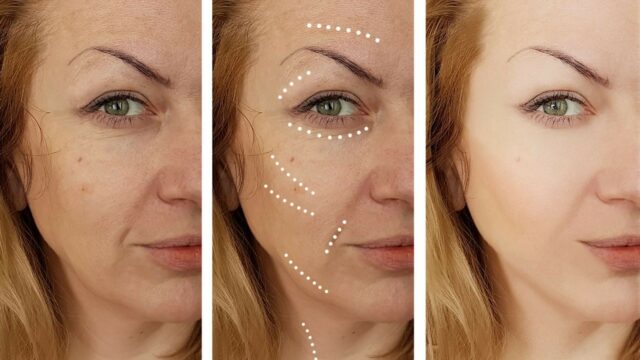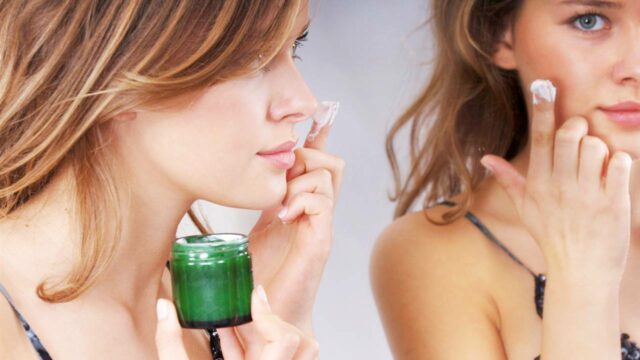In recent decades, the search for a face free of wrinkles and other signs of aging has gained a great ally: hyaluronic acid. It is a substance that can be applied to the inner layers of the skin to promote hydration. It is also used to plump the skin and give the desired contours on the chin, cheeks, lips, and eyelids.
Star of the popular “facial harmonization”, the ingredient has become synonymous with beauty products and today appears on the labels of many creams and in clinic and beauty clinic advertisements. But can it be used by everyone? Are there contraindications and side effects? And what is the difference between the creams that are sold in stores and the injections that are given in doctors’ offices?
With these 5 questions, we explain what are the main problems related to this product:
- What is hyaluronic acid?
Hyaluronic acid is a substance manufactured by our own body and that of many other animals. It has the function of maintaining the natural hydration of the cells that form the inner layers of the skin, as well as helping to support and fill this tissue.

“Over the years and the aging process, we lose the extracellular matrix of the skin, which becomes thinner and looser”, explains the doctor Alessandra Grassi Salles, coordinator of the Aesthetic, Cosmetic and Laser Surgery Group of the Department of Medicine from the University of Sao Paulo (USP), in Brazil. This “extracellular matrix” mentioned by the specialist corresponds precisely to all the substances that “fill” the skin and hold the skin cells together.
Over the years, and the natural decrease of these compounds, it is normal for the superficial layer of our body to become flaccid, gain wrinkles and end up becoming thinner. This is where hyaluronic acid applications come in; the goal is to replace or increase the amount of this substance, in order to keep the skin at the desired thickness.
- What is the difference between creams and injections?
“The big problem is that the hyaluronic acid that we produce naturally has a very short half-life. The body absorbs it in less than 48 hours”, says Dr. Daniel Boro, from the Brazilian Society of Plastic Surgery. “The industry then developed versions of this substance that are much more resistant and remain in the body for months”.
Currently, hyaluronic acid injected in aesthetic procedures is obtained through a fermentation process of some microorganisms. Creams carry synthetic versions of this ingredient. In addition to manufacturing, the 2 types of products have fundamental differences in the mechanism of action. “The basic function of the cream is to promote a very superficial hydration of the skin. Injectables have the function of filling, supporting and rejuvenating parts of the face”, sums up Dr. Alessandra Ribeiro Romiti, advisor to the Department of Dermatological Cosmetics of the Brazilian Society of Dermatology.
Specialists explain that the cream provides large molecules that cannot pass through the first layers of the skin. With this, there is no possibility that the hyaluronic acid that is part of the formulation deepens and fills the extracellular matrix mentioned above.
A similar moisturizing effect, by the way, is observed in the capsules that also contain this ingredient. However, before starting to use any of these elements, the ideal is to seek the guidance of an expert. “If the person has oily skin and uses too much cream, there is a risk that this habit will clog the pores of the skin and cause acne”, explains Salles.
- Who is hyaluronic acid suitable for?
In general, there is no recommendation that fits all people. “We can apply hyaluronic acid to ourselves as part of the skin aging management process,” says Boro. In Romiti’s opinion, everything will depend on what the patient is looking for and her individual characteristics. “There is no right age to start treatment. There are people who begin to work on dark circles at age 25, others seek to correct certain aspects of the face after bariatric surgery or want a more global approach when they reach 50 or 60 years”, she says.

Salles adds that, in addition to the possibilities of modifying certain aspects of the face with new aesthetic technologies such as hyaluronic acid, the health professional needs to understand the motivations of each person. “It is a big mistake to think that we need to have a 30-year-old face to be happy. If we don’t find out what is happening to the patient, he may even have a rejuvenated face, but he will never be truly satisfied”, she explains.
- Are the results of the application final?
No. Hyaluronic acid used in procedures lasts longer, but is gradually absorbed by the body; “it all depends on the type of gel, and where on the face it will be applied”, Boro replies. “In general terms, it remains in the layers of the skin for about a year, but this time usually varies between 6 and 18 months”.
It is worth clarifying here that not all hyaluronic acid is the same: there are more consistent formulations and others that are more malleable. The professional selects the appropriate type according to the part of the face and the desired effect. On the chin or jaw, for example, a firmer gel may be necessary. While on the lips or eyelids, it is better to apply a flexible and elastic product, which will allow a more natural movement of the mouth or eyes.
In addition to consistency, another factor that interferes with the duration of hyaluronic acid is the movement of facial structures. It tends to go away quickly in areas that move a lot, like the lips and eyes, and stays longer in parts that are less mobile, like the jaw.
But of course, experts do not wait until hyaluronic acid is completely exhausted to indicate new applications. “We do regular monitoring and we have protocols to make replacements, as needed”, says Boro.
- Is there a risk of side effects after the procedure?
Adverse effects can arise and it is important that both specialists and patients know how to identify them in order to act quickly and contain the damage. One of the most feared dangers occurs when the product is injected into the wrong part of the face. With this, hyaluronic acid can stop inside the blood vessels that supply the face, where it will cause a blockage that will lead to tissue death in parts of the nose, lips, or even blindness. “To minimize this risk, it is important to do this procedure with professionals who have a lot of experience and years of training”, says Salles. “This is not something you learn in a weekend course. It takes years of study to understand all the anatomical variations of the face and where the veins and arteries are likely to be. And even the most experienced specialists can make mistakes and inadvertently inject the substance into a (blood) vessel”.

To minimize damage, it is possible to use an enzyme called hyaluronidase, which has the function of absorbing incorrectly applied hyaluronic acid. But this “antidote” cannot be used in all situations either: there are patients who are allergic to hyaluronidase and develop severe reactions.
On the other hand, in addition to the blockage of arteries and veins, other possible side effects are inflammatory reactions, characterized by redness and swelling, and the formation of nodules at the injection site. The good news is that since the product is absorbed by the body, these problems are usually temporary.
Finally, Salles considers that the excessive application of hyaluronic acid —and the undesirable aesthetic results— can also be seen as an adverse event in some situations. “There are cases where 10 to 20 milliliters of hyaluronic acid are injected and impressive transformations are seen”, he observes. “But this can affect the movement of the face and the person no longer has a natural smile or expression. You have to find a balance so that the person feels good and can recognize their own face in the mirror”.

For those who have experienced shifts in consciousness and know that more peace, joy, and love awaits in a better living environment. A bold shared vision. A living community and hub for innovation. A sustainable ecosystem for living and working. A model for the new future.
